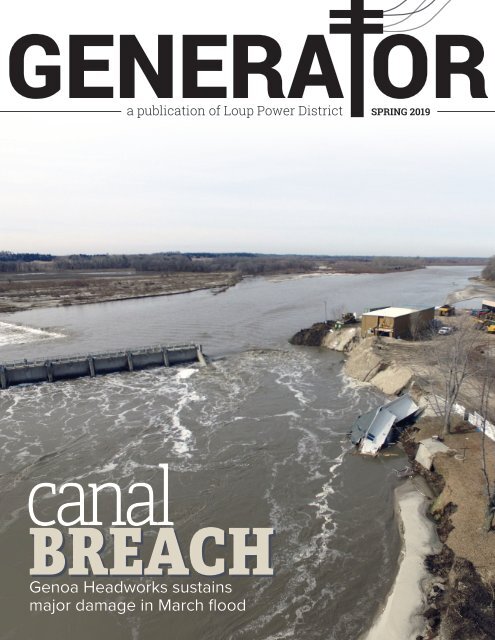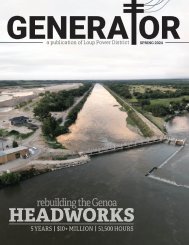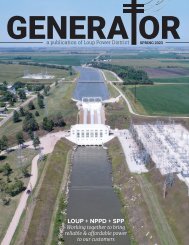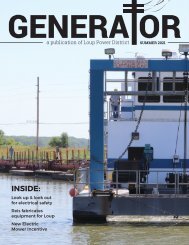Loup Generator - Spring 2019
A flood in mid-March breached the Loup Power District Canal, ripped away part of the shop at the Genoa Headworks, and destroyed a home. Read about the experience of Loup employees who tried to fight the flood and are now working to repair the damage it caused.
A flood in mid-March breached the Loup Power District Canal, ripped away part of the shop at the Genoa Headworks, and destroyed a home. Read about the experience of Loup employees who tried to fight the flood and are now working to repair the damage it caused.
- No tags were found...
Create successful ePaper yourself
Turn your PDF publications into a flip-book with our unique Google optimized e-Paper software.
GENERA OR<br />
a publication of <strong>Loup</strong> Power District SPRING <strong>2019</strong><br />
canal<br />
BREACH<br />
Genoa Headworks sustains<br />
major damage in March flood
BOARD<br />
OF DIRECTORS<br />
Larry Zach<br />
Chairman<br />
Chris Langemeier<br />
First Vice Chairman<br />
Ross Knott<br />
Second Vice Chairman<br />
Alan Drozd<br />
Secretary<br />
Dick Tooley<br />
Treasurer<br />
Rich Aerni<br />
Robert Cerv<br />
Jim Donoghue<br />
Mike Fleming<br />
Steve Heesacker<br />
EXECUTIVE STAFF<br />
Neal Suess<br />
President/ CEO<br />
Walt Williams<br />
Vice President,<br />
Administrative Services/CFO<br />
David Bell<br />
Vice President,<br />
Development/Marketing<br />
Ron Ziola<br />
Vice President, Engineering<br />
Dan Hellbusch<br />
Vice President, Operations<br />
The <strong>Loup</strong> <strong>Generator</strong> is<br />
published quarterly as a<br />
service for <strong>Loup</strong> employees,<br />
families, friends and<br />
associates.<br />
For feedback, story ideas<br />
and submissions, contact:<br />
Stacy Wemhoff<br />
Communications Coordinator<br />
402-562-5711<br />
swemhoff@loup.com<br />
2 GENERATOR<br />
watt we are<br />
In the four-county area on a 115 kV line<br />
My buddies and I travel along, always right on time.<br />
Into substations filled with transformers, breakers and switches we arrive;<br />
We can’t mess around here, because we leave on the 34.5.<br />
We do require insulators on cross arms mounted on a pole;<br />
We don’t want to take the chance of being grounded, we must reach our goal.<br />
For we are sent out on lines that have no end;<br />
Naturally, to satisfy all our customers is our trend.<br />
We enter your home on a line that’s very well fused;<br />
Just there waiting to prove we are wanting to be used.<br />
Even if we are in the 110, 220, or the 440-yard dash;<br />
You will find we don’t cost much in the line of cash.<br />
All year long, be it workday, holiday, daytime or night;<br />
With the flick of a switch, we can make dark become light.<br />
We can heat your water, warm your home, or even keep it cool;<br />
If we are not insulated, don’t touch us — is a very good rule.<br />
With a record on your stereo, we can make it play or sing;<br />
All of this is because we enjoy doing our thing.<br />
Now — what are we??<br />
We are your friends, the watts;<br />
And a thousand of us will make a kilowatt.<br />
— Eldon Sorensen<br />
“<br />
The above poem was written by <strong>Loup</strong> Power District’s undercover poet, Eldon<br />
Kenneth Sorensen of Genoa.<br />
Eldon, a dragline operator at the Genoa Headworks, was born<br />
of Danish descent in Lindsay on March 27, 1917, to Albert and<br />
Christina Sorensen.<br />
Eldon began writing poetry when he was a child going to country<br />
school. One day, the young lad, Eldon, received a letter from his<br />
girl-cousin in Minnesota. The letter contained a poem written<br />
by his cousin, and Eldon answered her poem with one he had<br />
written. Ever since then, Eldon has been writing poems about<br />
farming, his work, and his friends.<br />
Eldon was a Navy man for three years during World War II,<br />
stationed with the PT fleet in New Guinea and the English<br />
Channel.<br />
SORENSEN<br />
After 28-year-old Eldon was discharged from the service in 1945,<br />
he farmed for seven years. Then he worked as a mechanic for<br />
A. Clawson and V. J Shanahan of Genoa for 11 years. Eldon has been working with the <strong>Loup</strong><br />
Power District canal maintenance crew for the past seven years.<br />
His two main hobbies are golfing and bowling, and Eldon notes that his bowling game is<br />
a little better than his golfing average. He bowls for Wheelers Transport and in the Friday<br />
Night Mix at Genoa. Eldon is also a substitute for Westring and Sons, Inc. Bowling Team.<br />
Poet Sorensen is a hard-working employee and a strong promoter of the electric power<br />
industry — he will soon move into a new all-electric home that he is having built.<br />
— from the July 1971 issue of the <strong>Loup</strong> <strong>Generator</strong>
PRESIDENT'S MESSAGE<br />
Historic flood breaches canal,<br />
damages Genoa Headworks<br />
Historic flood waters devastated much of<br />
the state last month, including <strong>Loup</strong> Power<br />
District’s service area.<br />
Flooding occurred in all areas served by<br />
the District. The St. Edward substation and<br />
subtransmission lines south and west of<br />
Columbus were damaged.<br />
However, the most significant damage<br />
was to the Headworks and canal system.<br />
During the evening hours of March 12 and<br />
morning hours of March 13, rain and snow<br />
began to fall throughout Nebraska.<br />
Many areas of Nebraska became<br />
concerned about potential flooding due to<br />
a combination of warm temperatures, rain<br />
runoff and snow melt, ice jams, and frozen<br />
ground that was unable to absorb water.<br />
Officials with the City of Columbus and Platte County<br />
were concerned enough — especially with the large ice<br />
jam on the <strong>Loup</strong> River south of Columbus — that they<br />
contacted the District and asked us to divert as much<br />
water as possible into the canal at the Headworks.<br />
WEDNESDAY, MARCH 13<br />
Late in the day, the ice cap the District forms at the<br />
Headworks, which is used to divert water into the canal<br />
during the winter, broke up due to the rain fall and<br />
warmer temperatures.<br />
As night approached, District personnel noticed<br />
increasing water flows in the <strong>Loup</strong> River — much<br />
greater than the designed capacity of the canal. As<br />
higher and higher water flows continued, District<br />
personnel started sandbagging efforts at the Headworks<br />
intake structure, in order to help prevent more water<br />
from flowing into the Canal.<br />
THURSDAY, MARCH 14<br />
In the early morning hours, it became apparent that<br />
all personnel at the Headworks needed to evacuate for<br />
safety reasons. Around 2 a.m., District operators at the<br />
Columbus Powerhouse noticed unusually large flows<br />
into the Canal and were unsure of the ongoing issues.<br />
Around 3 a.m., the District implemented the<br />
Emergency Action Plan, developed for emergencies<br />
associated with the hydroelectric system. Individuals<br />
by NEAL SUESS<br />
President/CEO<br />
living in the High Hazard area near Genoa and<br />
areas in the southern part of the town were<br />
evacuated because of flooding.<br />
By daybreak, the District was aware of the<br />
significant flooding at the Headworks area and<br />
knew of at least one breach to the canal system,<br />
near the Highway 22 bridge south and west of<br />
Genoa.<br />
FRIDAY, MARCH 15<br />
District personnel were able to get to the<br />
Headworks area and begin to assess the damage<br />
to the Headworks and Canal with the help<br />
of a helicopter. They found massive damage.<br />
Two breaches near the intake structure were<br />
allowing uncontrolled water to flow into the<br />
Canal from the <strong>Loup</strong> River.<br />
In addition, there were six breaches of the canal that<br />
were allowing the water in the canal to flow onto the<br />
low-lying areas and fields near the Headworks.<br />
The good news is that all District personnel are safe.<br />
We did lose the caretaker house at the Headworks, but<br />
Andy Zarek and his family are safe and we are working<br />
with them to develop a temporary living solution.<br />
District personnel, working with several contractors<br />
and the Nebraska National Guard are working on<br />
temporary repairs. Initial damage estimates sent to the<br />
emergency management agencies for both temporary<br />
and permanent repairs are approximately $25 million.<br />
It will also take several months, if not years, to make<br />
finalized repairs.<br />
This event has been difficult on all District personnel,<br />
but we will survive this and become stronger in the<br />
end. These events show the destructive nature of our<br />
industry, so we always need to maintain a safe working<br />
environment, which our employees always have.<br />
The District wants to extend thanks to everyone for<br />
their help, especially Preferred Sands of Genoa and the<br />
Nebraska National Guard.<br />
This is a short update, and more information will<br />
be coming out in the weeks and months ahead. Please<br />
keep up with the various social media outlets, such as<br />
Facebook, for more timely updates as we work toward<br />
recovery.<br />
SPRING <strong>2019</strong> 3
COLUMBUS SERVICE<br />
CENTER WORK<br />
<strong>Loup</strong> employees were on the site of the new<br />
Columbus Service Center March 1 to pull cable.<br />
The building is located just south of Lost Creek<br />
Parkway and east of Monastery Road.<br />
The building will be completed this fall.<br />
4 GENERATOR
County payments total<br />
more than $2 million<br />
<strong>Loup</strong> Power District delivered<br />
its inside revenue payments and<br />
the second half of the “in-lieuof-tax”<br />
payment to the counties it<br />
serves.<br />
This is a benefit of being served<br />
by a locally controlled, not-forprofit<br />
utility.<br />
Like other businesses, <strong>Loup</strong><br />
Power District pays sales tax,<br />
gasoline taxes, motor vehicle<br />
license fees and permit fees.<br />
The “in-lieu-of-tax” payments<br />
are made to service area counties<br />
in lieu of occupation, personal<br />
property and real estate taxes.<br />
County treasurers distribute the<br />
funds to the various taxing bodies<br />
in each county.<br />
2018 in-lieu-of-tax payments:<br />
Platte — $4,856.89<br />
Boone — $2,539.17<br />
Nance — $3,222.92<br />
Colfax — $120.24<br />
Madison — $179.63<br />
Total — $10,918.85<br />
The District also makes<br />
additional payments to the<br />
counties to guarantee they receive<br />
5 percent of the inside revenues<br />
from the various towns in their<br />
areas subject to the in lieu-of-tax<br />
payments.<br />
Additional payments for 2018:<br />
Madison — $39,505.60<br />
Platte — $1,660,207.47<br />
Nance — $128,233.70<br />
Colfax — $93,275.56<br />
Boone — $198,411.86<br />
Total — $2,119,634.19<br />
Communities receive<br />
lease payments<br />
<strong>Loup</strong> officials presented lease payment checks to area<br />
communities in February and March. Each of these communities<br />
owns their electric distribution systems. These payments<br />
compensate them for the use of those systems.<br />
Communities use the funds for a variety of public projects.<br />
Primrose — $3,953.35<br />
St. Edward — $48,024.40<br />
Humphrey — $36,111.55<br />
Cornlea — $3,199.66<br />
Monroe — $20,328.87<br />
Tarnov — $2,446.67<br />
Platte Center — $18,345.39<br />
Petersburg — $25,348.33<br />
Columbus — $844,077.98<br />
Genoa — $11,735.00<br />
Creston — $5,488.30<br />
Second Half of 2018<br />
Albion — $121,366.54<br />
Cedar Rapids — $39,102.03<br />
Richland — $6,833.24<br />
Belgrade — $8,332.13<br />
Fullerton — $76,421.56<br />
Duncan — $32,584.46<br />
Howells — $48,323.93<br />
Clarkson —$48,604.65<br />
Fourth Quarter of 2018<br />
Lindsay — $44,063.86<br />
Leigh — $10,341.62<br />
Newman Grove — $16,515.41<br />
<strong>Loup</strong> renews<br />
community<br />
memberships<br />
<strong>Loup</strong> Power District renewed its<br />
membership in Community Clubs and<br />
Chambers of Commerce in towns throughout<br />
its service area.<br />
Checks totaling $30,414 were presented to<br />
communities in Boone, Colfax, Nance, Platte,<br />
and Madison counties. Payment amounts are<br />
based on the 2018 gross revenues inside each<br />
community.<br />
Albion Chamber — $1,598<br />
Cedar Rapids Community Club — $488<br />
Clarkson Commercial Club — $611<br />
Columbus Area Chamber — $21,385<br />
Fullerton Chamber — $1,097<br />
Genoa Chamber — $797<br />
Howells Community Club — $634<br />
Humphrey Community Club — $670<br />
Lindsay Community Club —$1,421<br />
Leigh Community Club —$100<br />
Newman Grove Community Club — $605<br />
Petersburg Community Club — $313<br />
Primrose Community Club — $100<br />
St. Edward Community Club —$595<br />
SPRING <strong>2019</strong> 5
6 GENERATOR
‘We were in awe’<br />
Flood estimate tops $20M<br />
The before and after photos illustrate the<br />
destructive power of water and ice.<br />
A home lost. A building damaged. Earth<br />
and concrete moved with apparent ease.<br />
Water everywhere. It seemed unbelievable.<br />
The water began rising March 13.<br />
<strong>Loup</strong> Power District employees tried to<br />
fight Mother Nature with sandbags and<br />
determination. But in the end, they had to<br />
concede.<br />
“We didn’t win this battle,” said Andy<br />
Zarek. “We’ll get the next one.”<br />
‘A recipe for disaster’<br />
Zarek began working for <strong>Loup</strong> Power<br />
District 20 years ago at the age of 18.<br />
Three years ago, he was named Headgates<br />
Operator and moved with this family to a<br />
District-owned home on the site.<br />
He knows the river can behave badly<br />
this time of year. He watches it daily.<br />
Listens to weather reports. Monitors the<br />
canal.<br />
Weather reports warned of a bomb<br />
cyclone that was forecast to hit much of<br />
Nebraska. The explosive storm, fueled by<br />
rapidly dropping atmospheric pressure,<br />
would hit like a winter hurricane. Still,<br />
Zarek wasn’t overly worried.<br />
On Monday, March 11, <strong>Loup</strong> employees<br />
broke up ice around the intake gates with<br />
dynamite and a crane. They noticed it was<br />
unusually thick — about two feet in spots.<br />
Usually, the weather warms up a bit<br />
in February, melting and breaking the<br />
river ice cap slowly. But this February was<br />
unusually cold. And early March followed<br />
suit, roaring in like a lion.<br />
Then, the forecast for Wednesday,<br />
March 13, called for highs around 60 °F<br />
with some heavy rain.<br />
“That’s a recipe for disaster,” he said.<br />
‘Way more than we expected’<br />
The <strong>Loup</strong> Power canal and two<br />
powerhouses were constructed in the<br />
1930s with a $7.3 million loan and grant<br />
from the Public Works Administration.<br />
The Genoa Headworks serves as the<br />
beginning of <strong>Loup</strong>’s canal system. Gates<br />
are adjusted as needed to direct the proper<br />
amount of water from the <strong>Loup</strong> River into<br />
the canal.<br />
More than 80 years of ice jams and<br />
heavy rains and snow melt have passed<br />
through the canal. Only once, in August<br />
of 1966, did those waters cause any<br />
substantial damage.<br />
Heavy rain filled the <strong>Loup</strong> River and<br />
spilled over the intake structure. The<br />
water flowed north and traveled along the<br />
side of the canal before washing out a road<br />
and going back into the canal.<br />
It also washed out two bridges and<br />
damaged a number of transmission lines.<br />
The District’s dredge — used to clean<br />
sediment from the two-mile settling<br />
basin at the start of the canal — washed<br />
downstream until it hit a tractor. The<br />
impact was nearly $600,000 — about $4.4<br />
million in today’s dollars.<br />
But that was more than 50 years ago.<br />
For the last 26, Randy Prososki has also<br />
watched over the river and canal. He took<br />
over as Headworks Supervisor last October<br />
following the retirement of Gary Pearson.<br />
Every year, the ice jams break up and<br />
go down river.<br />
“We were prepared for the ice to go<br />
out of the river like it does every year,”<br />
Prososki said.<br />
And that’s what happened on the<br />
afternoon of Wednesday, March 13. The<br />
first ice jam broke and went through the<br />
canal at around 3:30 p.m., followed by<br />
a second around 5 p.m. Then Prososki<br />
headed home.<br />
Zarek watched the ice go through the<br />
canal. It was a little thicker than usual<br />
and bent up a few of the gate arms, but<br />
he figured they could be replaced. He still<br />
wasn’t overly concerned, but asked his<br />
wife and two children to stay in Genoa<br />
with family. Better to err on the side of<br />
caution.<br />
Before and after aerial drone photos: The top photos show the north side canal breach and damage<br />
to the shop, boiler room and home at the Genoa Headworks.<br />
The bottom two photos show damage on the south side of the canal. Photos by Aric Alt.<br />
SPRING <strong>2019</strong> 7
The ice jam at the Highway 22 bridge.<br />
A third jam came through around<br />
7 p.m. Zarek sent a video to Prososki,<br />
who was alarmed at what he saw.<br />
Still, the jam passed and the river<br />
quieted down. But the water kept<br />
rising and Zarek became uneasy.<br />
He knew there must be an ice jam<br />
causing the water to back up.<br />
Prososki made his way back to the<br />
Headworks.<br />
“It was just way more than we<br />
expected,” he said.<br />
The water kept rising and around<br />
9:30 that evening, Prososki called<br />
employees asking them to help<br />
sandbag.<br />
“We couldn’t handle it anymore,”<br />
he said.<br />
‘The approach disappeared’<br />
Jesse Hoffmeister joined the Genoa<br />
Headworks maintenance crew in<br />
January. He worked his shift that<br />
Wednesday, leaving at 4 p.m.<br />
He made it home to St. Edward,<br />
about 10 miles north of the<br />
Headworks, only to find that the<br />
Beaver Creek was over its banks and<br />
flooding the town.<br />
As a member of the volunteer fire<br />
department, he began helping rescue<br />
stranded residents. He made it home<br />
around 9:45 p.m. when he got the call<br />
from Prososki asking for help.<br />
Because of the Beaver Creek<br />
flooding, he couldn’t take his normal<br />
route back to work. Instead, he<br />
traveled northwest to Albion and then<br />
back south and east.<br />
When he arrived at the Headworks<br />
around 11:30 p.m., he voiced his<br />
disbelief at the amount of water. The<br />
veteran employees told him it had<br />
8 GENERATOR<br />
been like this before. Everything<br />
would be okay.<br />
Hoffmeister and the other<br />
employees began sandbagging the<br />
intake structure approach.<br />
“We thought we were getting<br />
ahead of it,” he said.<br />
Suddenly, they heard a pop and<br />
ran about 30 yards toward the shop.<br />
“The light pole just started<br />
falling over and the whole approach<br />
disappeared,” Hoffmeister said.<br />
John Fritzges, like Hoffmeister,<br />
is new to his job. He is also on the<br />
maintenance crew and was a few<br />
weeks away from his one-year<br />
anniversary when he got the call<br />
asking him to sandbag.<br />
“The most unnerving thing was<br />
just watching that approach go in<br />
after we had just gotten off of it,” he<br />
said.<br />
Zarek said the 10-man crew just<br />
couldn’t keep up with the rising river.<br />
“We tried for three hours, but it<br />
just wasn’t enough,” he said.<br />
‘It was a nightmare’<br />
The water successfully breached on<br />
the north side of the intake structure.<br />
“It washed out all the concrete<br />
and dirt and made a 30-foot waterfall<br />
until it ate out enough to drain<br />
the river through the whole canal<br />
system,” Zarek said.<br />
Employees knew they had to leave<br />
quickly. The water was starting to<br />
flow north to Preferred Sands and<br />
they realized Headworks Park was<br />
going to flood as well, blocking their<br />
exit.<br />
Prososki ensured the crew got out<br />
of the area and told them to head<br />
Flooding at Headworks Park.<br />
home while he stayed to watch over<br />
the Headworks. About 1:30 a.m. on<br />
Thursday morning, he saw the intake<br />
structure walls begin to fully give way<br />
to the river.<br />
A boiler room sits on the edge of<br />
the canal. Crews use it to steam ice<br />
from the gates in winter. Prososki<br />
watched the water consume it, too,<br />
before deciding it was time to go.<br />
He drove over ice chunks to make<br />
it to the highway. There, he waited<br />
for daylight and prayed the canal<br />
wouldn’t breach in Genoa, about five<br />
miles to the northeast.<br />
Meanwhile, Zarek was trying to<br />
make it to Genoa. The familiar, short<br />
trip took almost an hour and a half<br />
because the Beaver Creek flooding<br />
made its way downstream from St.<br />
Edward.<br />
He went west to Fullerton and<br />
north to Albion. Then he took gravel<br />
roads back to St. Edward and Genoa,<br />
making it into town around 2 a.m.
Top left: A breach by the Highway 22 bridge.<br />
Photo by Aric Alt.<br />
Middle left: A home at the Headworks was destroyed in<br />
the flood. Headgates Operator Andy Zarek lived in the<br />
home with his family.<br />
Top right: Flood waters ripped off an addition to the<br />
Headworks Shop.<br />
Middle right: Derek Stankoski with Preferred Sands helps<br />
close a canal breach.<br />
Below: The weir bridge was ripped away during flooding,<br />
leaving crews with no way to make it to the south side of<br />
the canal. Photo by Aric Alt.<br />
SPRING <strong>2019</strong> 9
An hour later, <strong>Loup</strong> officials<br />
activated the Emergency Action<br />
Plan, which called for evacuations<br />
of residents in the high-hazard area<br />
near the canal.<br />
By 3:30 a.m., Zarek, also a<br />
volunteer firefighter, began knocking<br />
on doors just as the storm’s winds<br />
and snow hit the area.<br />
“We were sandbagging in t-shirts.<br />
Two hours later, everybody was<br />
looking for coveralls and winter coats<br />
because it’s snowing and blowing,”<br />
Zarek said. “It was a nightmare.”<br />
‘Never in my lifetime’<br />
At daybreak on Thursday, March<br />
14, Prososki was able to make it to<br />
the Highway 22 bridge, a few miles<br />
southwest of Genoa, where he saw a<br />
large breach.<br />
He and other employees were<br />
anxious to survey damage at the<br />
Headworks, but the roads to get there<br />
were washed away. Fierce winds<br />
prevented helicopters and drones<br />
from flying.<br />
By Friday morning, those winds<br />
died down and helicopter pilot Kim<br />
Wolfe flew a few employees to the<br />
Headworks for the first time since<br />
Wednesday night.<br />
They found six breaches, including<br />
two gaping holes on each side of<br />
the intake structure. Zarek’s home<br />
tipped into the canal. The parking lot<br />
missing. A 2016 addition to the shop<br />
ripped off. The weir bridge gone.<br />
“We were all in awe,” said<br />
Dan Hellbusch, Vice President of<br />
Operations.<br />
Prososki said the damage was<br />
There is a light at the<br />
end of this tunnel.<br />
devastating. “I would have never<br />
in my lifetime thought this would<br />
happen,” he said.<br />
It was especially so for Zarek,<br />
whose work and home lives mesh in a<br />
unique way at the Headworks.<br />
“You can’t go home because it’s<br />
gone,” he said.<br />
Then, he gestures to the canal and<br />
shop.<br />
“This is like a second home and<br />
it’s partly gone,” he said. “Where<br />
do you start? What do you do? It’s<br />
tough.”<br />
‘We could fill a need’<br />
The intake structure, emblazoned<br />
with the year 1936, stood its ground<br />
during the barrage — a testament<br />
of <strong>Loup</strong>’s history and strength,<br />
encouragement to those looking<br />
forward.<br />
And that’s exactly what employees<br />
did as soon as they saw the damage.<br />
“We started piecing things<br />
together and getting a plan of what<br />
we were going to do,” Zarek said.<br />
There wasn’t really much time<br />
for decisions, Hellbusch said. “We<br />
just knew we needed to get the water<br />
stopped,” he said.<br />
But first, crews had to get to<br />
the Headworks. The roads were<br />
impassable.<br />
It was a problem echoed across the<br />
state as county after county declared<br />
emergencies due to catastrophic<br />
flooding. Rivers broke levees and<br />
washed out roads.<br />
Despite the losses, Nebraska<br />
Strong became a mantra that<br />
motivated and inspired people to aid<br />
their neighbors, near and far. The<br />
same held true for the Headworks’<br />
neighbor, Preferred Sands.<br />
The company’s sand processing<br />
plant sits just over the hill to the<br />
north of the Headworks. It purchases<br />
sand dredged from the canal’s<br />
settling basin and produces silica<br />
sand and resin-coated products.<br />
Production Manager Keith Ferris<br />
was at the Preferred site that<br />
Wednesday evening, keeping an eye<br />
on things. When the power went out,<br />
he knew it meant trouble for <strong>Loup</strong>.<br />
Ferris has a close connection to the<br />
Headworks. He grew up in the area.<br />
His father, Lance, works for <strong>Loup</strong>. His<br />
great-grandfather did as well.<br />
“I know if we needed help, they’d<br />
help us,” he said.<br />
Plant Manager Scott Teigen said it<br />
didn’t take long for Ferris to suggest<br />
they help their neighbors.<br />
“Keith jumped in and realized we<br />
have a dozer, we have the excavators<br />
and we have the trucks,” he said. “We<br />
could easily fill a need.”<br />
The plant closed due to flooding<br />
and power loss. Both Preferred and<br />
the Headworks lost power because<br />
of damage to two substations along<br />
the canal and power poles near the<br />
Highway 22 breach.<br />
Right: A Black Hawk helicopter drops sandbags into the south-side canal breach. The National Guard used 280 sand bags to fill the gap.<br />
Below: National Guard Soldiers prepare to drop sandbags into the breach.<br />
10 GENERATOR
Far left: A 1,500-pound<br />
sandbag is carried by a<br />
telehandler.<br />
Left: Dalton Osantowski, a<br />
certified rigger with Flat River<br />
Corp. helps Maintenance<br />
Man Jesse Hoffmeister and<br />
Equipment Operator Joe<br />
Kleckner load sand into a<br />
conveyor to fill sandbags.<br />
The National Guard required<br />
that a certified rigger be at the<br />
site during the operation.<br />
SPRING <strong>2019</strong> 11
On Saturday, Preferred employees<br />
created a makeshift road from their<br />
plant over the sand pile so they could<br />
drive their trucks to the Headworks.<br />
Later that day, they began hauling<br />
dirt and rock to help fill the northside<br />
canal breach. The river was still<br />
high and it felt like a losing battle at<br />
first, the water washing away their<br />
effort.<br />
But they persisted, emptying large<br />
40-ton dump trucks with each load,<br />
finally closing the gap on Tuesday,<br />
March 18.<br />
“The guys don’t have to be here,”<br />
Ferris said. But they wanted to help.<br />
“There is a light at the end of this<br />
tunnel.”<br />
‘You just react and pray’<br />
The <strong>Loup</strong> River was still flowing in<br />
and out of the canal through another<br />
two major breaches — one on the<br />
south side of the intake structure and<br />
another near the Highway 22 bridge<br />
that was causing damage to Highway<br />
39.<br />
The weir bridge washed away<br />
during the flood so there was no easy<br />
way to get equipment to the south<br />
side of the canal.<br />
By the weekend, flooding was<br />
affecting additional portions of the<br />
state. The Nebraska National Guard<br />
dropped sandbags near Ashland to<br />
protect water wells used by the city of<br />
Lincoln.<br />
That sparked an idea for Ron Ziola,<br />
Vice President of Engineering.<br />
He began making calls, starting<br />
with the Nebraska Department of<br />
Natural Resources. Staff members<br />
there directed him to the Army Corps<br />
of Engineers who offered to arrange<br />
a helicopter and get large, vertical lift<br />
sandbags for the District.<br />
Preferred Sands also had extra<br />
sandbags on site that they brought<br />
to the Headworks. They hauled sand<br />
in their trucks while <strong>Loup</strong> employees<br />
filled the 1,500-pound sandbags with<br />
the help of a belt conveyor on loan<br />
from Preferred.<br />
Everything was on track until<br />
District managers received word<br />
that requests for assistance must<br />
come through Nebraska Emergency<br />
Management Agency (NEMA).<br />
12 GENERATOR
Top: Equipment Operator Jack Jones<br />
(left) and Randy Prososki assess damage<br />
at the Headworks.<br />
Left: National Guard soldiers rig up an<br />
ATV to carry to the south side of the<br />
canal.<br />
Below: Headworks crews filled the north<br />
side breach with the help of employees<br />
from Preferred Sands.<br />
Opposite page: Headgates Operator<br />
Andy Zarek and Maintenance Man John<br />
Fritzges climb a ladder to the intake<br />
structure to make their way to the south<br />
side of the canal.<br />
There, they retrieved the slings used to<br />
carry the sandbags by the helicopter.<br />
SPRING <strong>2019</strong> 13
Denise Ziemba, Region 44<br />
Emergency Manager, was a little<br />
more than six months into her<br />
new role as Region 44 Emergency<br />
Manager, when the flooding hit. She<br />
studied, prepared and planned as<br />
much as possible in those months.<br />
“I don’t think any plan could<br />
prepare you for what would happen,”<br />
she said. “You just react and pray that<br />
the decisions you’re making are the<br />
right ones,” she said.<br />
Ziemba helped coordinate the<br />
earlier evacuations of Genoa and was<br />
working through disaster relief in<br />
Boone, Merrick and Nance Counties.<br />
She was also in contact with Ziola,<br />
and Neal Suess, <strong>Loup</strong> President/CEO,<br />
trying to get damage cost estimates<br />
as well as updates on efforts to fill<br />
the breaches.<br />
Ziemba agreed the District needed<br />
sandbags to help fill the main<br />
south side breach and called NEMA<br />
requesting aid.<br />
On Thursday, a week after the<br />
breach, two Black Hawk helicopters<br />
landed at the Headworks with 18<br />
Nebraska National Guard soldiers<br />
who were ready to help.<br />
The National Guard worked for<br />
three days to fill the breach, finishing<br />
on Saturday, March 23. It took 280<br />
sandbags.<br />
Preferred employees continued to<br />
haul sand and rebuild the permanent<br />
road that runs from Headworks<br />
Park along the canal to the shop.<br />
Koch Excavating and Bygland Dirt<br />
Contracting, Inc., were also working<br />
on roads in the area.<br />
Crews restored power to the<br />
Headworks and Preferred Sands on<br />
Wednesday, March 27, with the help<br />
of Schmader Electric.<br />
Preferred employees helped close<br />
the large breach by the Highway 22<br />
bridge on Friday, March 29.<br />
And on Saturday, March 30, <strong>Loup</strong><br />
employees got their first chance to<br />
rest after working every day for more<br />
than two weeks.<br />
‘A long road ahead’<br />
District personnel are now<br />
working to turn temporary fixes into<br />
permanent repairs.<br />
The canal walls need riprap. Crews<br />
have to build a new bridge. The<br />
dredge took on water during the flood<br />
Top: The canal breaches and sandbags at the Genoa Headworks. Nebraska National<br />
Guard photo by Army Staff Sgt. Koan Nissen.<br />
Bottom: One Nebraska National Guard Black Hawk helicopter begins to lift a<br />
sandbag while another waits.<br />
and has two motors to be replaced.<br />
The flood damage estimate sits<br />
somewhere between $20 and $25<br />
million.<br />
Hellbusch said this damage is more<br />
extensive than that sustained in the<br />
flood of 1966 and will take more time.<br />
The weather conditions also affect<br />
repairs.<br />
The 1966 flood followed heavy<br />
rains during an August drought.<br />
This storm hit as the rainy season<br />
is just beginning. In the first few<br />
weeks following the flood, there was<br />
more rain and clouds than sun.<br />
“We’ve got a lot more obstacles to<br />
fight,” he said.<br />
The District’s two powerhouses<br />
were not damaged in the flood<br />
and <strong>Loup</strong> continued to generate<br />
electricity.<br />
“We continued generating to lower<br />
water levels to alleviate flooding,”<br />
said Hydro Superintendent Brad<br />
14 GENERATOR
Above: Staff Sgt. Joseph Yates looks out the door of his UH-60 Black Hawk helicopter during sandbagging operations March 23.<br />
Nebraska National Guard photo by Army Staff Sgt. Koan Nissen.<br />
Top right: Heavy Equipment Operator Kurt Mohr reinforces the sandbag dike on the south side of the canal.<br />
Bottom right: A National Guard Chinook helicopter carries a Bobcat loader to the south side of the canal. Photo by Dan Hellbusch.<br />
Morton.<br />
While the emergency was<br />
overwhelming at times, Hellbusch<br />
said <strong>Loup</strong> employees always jump<br />
in and get right to work following<br />
storms. He’s seen it time and again in<br />
his 34 years with the company.<br />
“It’s all we’ve ever done,” he said.<br />
“Everybody is willing to pitch in and<br />
help.”<br />
Zarek said working 12-hour days<br />
for weeks with his coworkers was<br />
difficult, but they helped each other<br />
through the struggle.<br />
“It’s like a family,” he said.<br />
Prososki knows it’s a long road,<br />
but he is quick to put the fight into<br />
perspective. <strong>Loup</strong> Power isn’t alone<br />
in trying to recover from a historic<br />
flood.<br />
NEMA estimates that 95 percent<br />
of Nebraskans were affected by the<br />
March storms.<br />
“We had a family that lost<br />
everything they owned. Other families<br />
did, too,” he said. “Everybody’s had a<br />
loss of some kind.<br />
Despite his loss, Zarek remains<br />
upbeat and positive that things will<br />
get back to normal.<br />
“We’ll get this back together and<br />
life will go on. It will look great,” he<br />
said.<br />
“We just need a little time.”<br />
by Stacy Wemhoff | swemhoff@loup.com<br />
SPRING <strong>2019</strong> 15
around the District<br />
CLARKSON OPERA HOUSE<br />
The Clarkson Opera House has<br />
hosted dances, talent shows, concerts<br />
and receptions for more than 100<br />
years.<br />
“It’s a great old building,” said<br />
Chuck Hamernik.<br />
He’s a member of The Clarkson<br />
Community Opera House, Inc., a<br />
nonprofit organization that formed in<br />
2002 to ensure that the Opera House<br />
will host events for years to come.<br />
The history of the Opera House<br />
dates back to the late 1800s when<br />
a fraternal organization formed in<br />
Clarkson. They met in businesses<br />
around town before building their<br />
own hall in 1891.<br />
As the Western Bohemian Fraternal<br />
Association (Zapadni Cesko Bratrska<br />
Jednota) grew in membership it<br />
outgrew the building.<br />
The new Opera House was built in<br />
the fall of 1915 and the ZCBJ had its<br />
first meeting there in January of 1916.<br />
It began showing movies in 1930<br />
and hosted many school events before<br />
Clarkson’s modern high school was<br />
constructed in 1952.<br />
The Lion’s Club leased the Opera<br />
House from 1958 through 1961 and<br />
continued to show movies and host<br />
public gatherings.<br />
VFW Cornhusker Post 6419 took<br />
over the lease in 1961 and took care of<br />
the building for 40 years.<br />
When the VFW and Ladies<br />
Auxiliary decided they couldn’t<br />
maintain the building due to their<br />
advanced ages, the nonprofit group<br />
stepped in to take over.<br />
With the help of donations, the<br />
group has updated and maintained<br />
the building for the last 16 years.<br />
Hamernik said they added central<br />
air conditioning and new windows<br />
and refinished the floors several<br />
times.<br />
Another big project is restoring the<br />
hand-painted curtains. One has been<br />
completed with seven remaining. The<br />
curtains are in fairly good shape with<br />
a bit of water damage. They were<br />
painted in the 1920s and 30s.<br />
The Opera House is listed on the<br />
National Register of Historic Places in<br />
Nebraska. It continues to be the site<br />
of community events and hosted the<br />
Glen Miller Band, a Beatles tribute<br />
band, and Elvis impersonator in the<br />
last few years.<br />
16 GENERATOR
Above: The Opera House featured eight hand-painted curtains. This is the first to<br />
be restored and was painted in 1929. It features Svatopluk, a Moravian king who<br />
ruled in the late 800s. His three sons wanted to split the kingdom so they could<br />
each rule a portion.<br />
The curtain features the legend of the three twigs. Just before his death, Svatopluk<br />
asked his sons to come to him and to bring twigs. He asked his sons to break a<br />
single twig, which they did easily. He then bundled the sticks and asked them to<br />
break the bundle, which was not possible.<br />
“The moral of the story is, ‘Stay together and you’ll be strong. If you’re an individual,<br />
you’ll be easily broken,’ “ said Chuck Hamernik, who serves as Clarkson’s mayor<br />
and helps maintain the Opera House.<br />
The brothers did not listen, fighting for control of the throne following Svatopluk’s<br />
death. Their division lead to the fall of the Moravian Empire.<br />
Top right: Hamernik lowers a curtain at the Opera House.<br />
Bottom right: One of eight curtains at the Opera House awaiting restoration.<br />
Below: A view of the Opera House from the balcony. A gymnastics class meets<br />
there a few times a week.<br />
The Opera House is open by appointment.<br />
clarksonoperahouse.org<br />
340 Pine St., Clarkson, Neb.<br />
402-892-2457<br />
SPRING <strong>2019</strong> 17
employee notes<br />
JON BLASER<br />
Customer Service Supervisor<br />
20 years<br />
Jon Blaser of rural Columbus joined <strong>Loup</strong> in 1999 as Accountant/Collector at the<br />
Columbus General Office. He was promoted to Customer Service Supervisor in 2016.<br />
As Customer Service Supervisor, Blaser’s responsibilities include supervision in the<br />
areas of customer services, meter reading, and billing.<br />
A graduate of Monroe High School, Blaser earned an Associate of Applied Science<br />
Degree in Accounting from Lincoln School of Commerce.<br />
Blaser and his wife, Gina, are the parents of three children — Jessica, Connor, and<br />
Colton.<br />
10 Years<br />
ANDREW SCHMIDT<br />
Heavy Equipment Operator<br />
Andy Schmidt joined <strong>Loup</strong> in<br />
2009 as a Maintenance Man on<br />
the Columbus Canal Crew. He was<br />
promoted to Equipment Operator<br />
in 2011 and was named Heavy<br />
Equipment Operator in 2016.<br />
As Heavy Equipment Operator,<br />
Schmidt’s duties include canal<br />
maintenance from Columbus to<br />
Genoa. In addition to his work at<br />
both the Columbus and Monroe<br />
powerhouses, he runs the dragline<br />
and operates the trash rake at<br />
Monroe.<br />
A native of Monroe, Schmidt is<br />
a graduate of Monroe High School.<br />
He and his wife, Stephanie, are the<br />
parents of two daughters — Whitney<br />
and Lindy.<br />
10 years<br />
MICHAEL JONES<br />
Computer Support<br />
Specialist<br />
Michael Jones of Columbus<br />
joined <strong>Loup</strong> in 2009 as Computer<br />
Support Specialist at the Columbus<br />
General Office.<br />
His duties include installing,<br />
maintaining, and repairing<br />
the computers, software, and<br />
communications systems<br />
throughout the District.<br />
Jones was born in Columbus<br />
and grew up in the Rockford,<br />
Illinois, area. He graduated from<br />
Harlem High School in Loves Park,<br />
Illinois and studied Information<br />
Technology-Electronic at Central<br />
Community College-Columbus.<br />
Jones and his wife, Beth, are the<br />
parents of three sons — Benjamin,<br />
Steven, and David.<br />
Welcome<br />
JEREMY MOORE<br />
Columbus Plant Operator<br />
Jeremy Moore of Columbus joined<br />
<strong>Loup</strong> Power District as a Plant Operator<br />
at the Columbus Powerhouse.<br />
As a plant operator, Moore monitors<br />
and controls the three generation units<br />
at Columbus and remotely controls the<br />
Monroe Powerhouse. He also works<br />
closely with the Genoa Headworks to<br />
divert maximum <strong>Loup</strong> River water into<br />
the District canal system for power<br />
plant generation.<br />
Moore’s other duties include<br />
coordinating generation with NPPD’s<br />
control center in Doniphan and<br />
monitoring <strong>Loup</strong>’s 115 kV and 34.5 kV<br />
subtransmission system.<br />
Moore is a graduate of Cedar Rapids<br />
High School. He and his wife, Carri,<br />
have three sons — Talon, Parker, and<br />
Barrett.<br />
18 GENERATOR
SHEILA SUP<br />
Columbus Service Center Coordinator<br />
Sheila Sup has been promoted to Columbus Service Center Coordinator.<br />
She joined <strong>Loup</strong> Power District in 2012 as a Customer Service Representative at the Albion<br />
Office and remained in that position until this promotion.<br />
As the Service Center Coordinator, Sup handles communication among the personnel at<br />
the Service Center including linemen and meter and maintenance, shop, and canal crews.<br />
Her duties include taking service calls, receiving locate requests, sending irrigation load<br />
control messages and handling dispatches. She also prepares work tickets, service orders,<br />
and reports.<br />
Sup is a graduate of Boone Central High School. She attended the University of Nebraska-<br />
Lincoln and earned a BA degree in Communication Studies.<br />
Promoted<br />
Heesacker joins <strong>Loup</strong> Board<br />
Steve Heesacker of Humphrey joined <strong>Loup</strong> Power District’s Board of<br />
Directors in January.<br />
Promoted<br />
NATALIE SHARMAN<br />
Customer Service Rep<br />
Natalie Sharman of Fullerton has<br />
been promoted to a Full-Time Customer<br />
Service Representative.<br />
She has worked for more than three<br />
years as part-time CSR in the St. Edward<br />
Office. With this promotion, she now<br />
serves in both the Fullerton and Albion<br />
offices.<br />
As a Customer Service Representative<br />
Sharman’s responsibilities include<br />
greeting customers; processing<br />
payments; setting up, transferring, or<br />
closing service; taking service calls; and<br />
preparing reports.<br />
Sharman is a native of Cambridge and<br />
a graduate of Cambridge High School.<br />
She studied business and marketing at<br />
the University of Nebraska-Kearney.<br />
Sharman and her husband, Les, are<br />
the parents of two children, Braden and<br />
Kinzie. They also own Shamz Auto Body<br />
in Fullerton.<br />
He represents Subdivision 3,<br />
which includes portions of<br />
Platte and Colfax Counties.<br />
Heesacker farms in the<br />
Humphrey area and also<br />
owns a realty and auction<br />
business.<br />
He decided to run for the<br />
open seat after a phone call<br />
with retiring board member<br />
Francis Sand.<br />
“After the nice conversation<br />
with him and some serious<br />
thought, I decided to file,”<br />
Heesacker said.<br />
After filing for the open seat,<br />
Heesacker began attending<br />
<strong>Loup</strong>’s board meetings to<br />
learn more about the District.<br />
“I found it very interesting<br />
and got more excited about being on the board,” he said.<br />
He is looking forward to the completion of the new Columbus Service<br />
Center and the economic development in that area.<br />
While he still has a lot to learn about <strong>Loup</strong>, Heesacker said he believes<br />
in the public power model.<br />
“I want to continue making the right decisions to provide affordable,<br />
reliable electricity,” he said.<br />
SPRING <strong>2019</strong> 19
employee notes<br />
ED ELM<br />
Equipment Operator<br />
Retired<br />
Ed Elm joined <strong>Loup</strong> in 1977 as a Maintenance Man at the Genoa Headworks. He was<br />
promoted to Assistant Dredge Operator in 1979 and to Heavy Equipment Relief Operator in<br />
1981.<br />
In 1982, Elm transferred to Columbus and was promoted to Heavy Tractor Operator. His<br />
title was changed to Equipment Operator in 1986 and he continued in that position until<br />
his retirement.<br />
As an Equipment Operator, Elm operated the District’s heavy equipment and was part<br />
of the crew that performs maintenance on the canal system from Genoa to Columbus. He<br />
also worked at the two powerhouses when needed, helped build substations, and took care<br />
of District parks and lakes.<br />
Elm is a graduate of Genoa High School and attended Central Community College–<br />
Columbus. He and his wife, Christine, are the parents of three sons: Adam, Austin, and<br />
Alden.<br />
5 Years<br />
BRANDON RAMAEKERS<br />
Journeyman Lineman<br />
Brandon Ramaekers joined <strong>Loup</strong><br />
Power District in 2014 as a Lineman<br />
on the Columbus Line Crew at the<br />
Columbus Service Center.<br />
He was promoted to Journeyman<br />
Lineman in 2016.<br />
As a Journeyman Lineman,<br />
Ramaekers is a member of the<br />
line crew that is responsible for<br />
the construction, operation, and<br />
maintenance of <strong>Loup</strong>’s electrical<br />
transmission and distribution system<br />
in the Columbus Division.<br />
A graduate of Norfolk Catholic<br />
High School, Ramaekers earned an<br />
Associate of Applied Science Degree<br />
in Utility Line from Northeast<br />
Community College in Norfolk.<br />
Welcome<br />
JESSE HOFFMEISTER<br />
Maintenance Man<br />
Jesse Hoffmeister of St. Edward<br />
joined <strong>Loup</strong> Power District as a<br />
Maintenance Man at the Genoa<br />
Headworks.<br />
In his new position,<br />
Hoffmeister is responsible for<br />
maintaining the District’s parks,<br />
facilities and equipment. He also<br />
assists equipment operators and<br />
serves as a dredge deck hand<br />
during the dredging season at the<br />
Genoa Headworks.<br />
Hoffmeister is a graduate of St.<br />
Edward High School. He and his<br />
wife, Haylee, have two sons —<br />
Mason and Ryker.<br />
1 year<br />
CINDY GASPER<br />
Customer Service Rep<br />
Cindy Gasper of Columbus<br />
joined <strong>Loup</strong> Power District as a<br />
Customer Service Representative<br />
at the Columbus General Office in<br />
2018.<br />
Gasper’s responsibilities<br />
include greeting customers,<br />
processing payments, setting up<br />
and closing service, and answering<br />
phone calls.<br />
Gasper is a native of Humphrey.<br />
She and her husband, Greg, have<br />
four children: Lindsey, Levi,<br />
Mikayla, and Michael.<br />
Gasper has owned Party Palace<br />
in Columbus for 21 years.<br />
20 GENERATOR
Ho<br />
find the answers with<br />
ENERGY ADVISOR<br />
Our new online Energy Advisor energy calculator<br />
is accessible from your computer or mobile device<br />
at www.loup.com.<br />
The tool offers a detailed report of your energy use<br />
including month-to-month comparisons, plus tips<br />
for no-cost and low-cost home improvements to<br />
help you stretch your energy dollars.<br />
Follow the tips below to get started.<br />
1: Take a quick survey<br />
Visit www.loup.com and find the Home Energy<br />
Advisor link under the “Save Money” menu.<br />
Take a few minutes to tell us about your home. Is it<br />
large or small? Well-insulated or under-insulated?<br />
How many people are living there? What appliances<br />
are drawing on electricity, and how is your<br />
thermostat typically set?<br />
After clicking,<br />
“Calculate,” you’ll<br />
instantly receive a<br />
detailed breakdown of<br />
the energy consumption<br />
in your home.<br />
2: Explore your energy use<br />
Colorful charts and<br />
graphs explain where your actual energy dollars are<br />
going and how your usage has changed over time.<br />
Discover opportunities for<br />
improvement with<br />
customized energy-saving<br />
recommendations<br />
based on<br />
your survey<br />
responses.<br />
All of the tips are<br />
easy and cost little<br />
or no money to<br />
implement.<br />
Best of all, Energy<br />
Advisor will tell<br />
you exactly how<br />
much you could<br />
save!<br />
3: Find easy ways to save<br />
SPRING <strong>2019</strong> 21
TREE PLANTING GUIDE<br />
Trees that grow into or near power lines can<br />
threaten the safety and reliability of your electric<br />
service. They can cause sparks, fires, and power<br />
outages.<br />
This is especially true with storms that bring<br />
lighting, wind or ice.<br />
Before you plant trees, take a look around to see<br />
how they will affect overhead utility lines as they<br />
grow.<br />
Planting tall-growing trees under utility lines will<br />
require <strong>Loup</strong> personnel to prune them to maintain<br />
safe clearance.<br />
Where you plant trees can also affect<br />
temperatures in your home.<br />
Deciduous trees on the south, east and west sides<br />
of your home will provide cooling shade in the<br />
summer.<br />
They will lose their leaves in the winter, allowing<br />
the sun to warm your home in the cooler months.<br />
Evergreen trees and shrubs can also help you save<br />
energy by slowing cold winter winds.<br />
How tall will your tree grow? A good rule of<br />
thumb is to plant it at least that far from the<br />
utility lines.<br />
10' 20' 30' 40' 50' 60' 70'<br />
STOP<br />
NO TREE ZONE<br />
No trees within<br />
25' of power lines<br />
CAUTION<br />
SMALL TREE ZONE<br />
Plant trees less than 25'<br />
in height/spread<br />
at least 25' from<br />
power lines<br />
CAUTION<br />
MEDIUM TREE ZONE<br />
Plant trees 25'–40' in<br />
height/spread at least<br />
40' from overhead<br />
power lines<br />
GO<br />
LARGE TREE ZONE<br />
Plant trees larger than<br />
40' in height/spread at<br />
least 60' from overhead<br />
power lines<br />
22 GENERATOR
LOWERING PIPELINES<br />
The Headworks crew took advantage of a beautiful<br />
January day to lower the dredge discharge pipelines.<br />
Employees raised the piplines over the years as sand<br />
piled up. Preferred Sands removed much of the sand in<br />
the area, prompting the need to lower them again.<br />
Doing so prevents the swirling water from washing away<br />
the pilings.<br />
At left, Kenton Zimmer and John Fritzges work on one of<br />
the pipelines. Pictured above are a pipeline that is being<br />
lowered and one that is finished.<br />
NEW BARREL PONTOONS<br />
The barrell pontoons that hold the dredge’s floating<br />
pipeline are aging and need to be replaced.<br />
There aren’t any available locally, so the Headworks crew<br />
is making their own.<br />
At left, Bob Anderson grinds areas on the new pontoon<br />
that need to be welded. There are 10 pontoons that need<br />
to be replaced.<br />
SPRING <strong>2019</strong> 23
2404 15th Street | PO Box 988<br />
Columbus, NE 68602-0988<br />
Nebraska Army National Guard riggers, Staff Sgt.<br />
William Cozad, Sgt. Luis Rocha, and Spc. Jacob Mason<br />
inspect a Bobcat loader prior to sling load operations<br />
at the Genoa Headworks on March 26.<br />
The riggers were part of a team that prepared the<br />
loader for air transport to the south side of the canal.<br />
Nebraska National Guard photo by Staff Sgt. Koan Nissen.

















